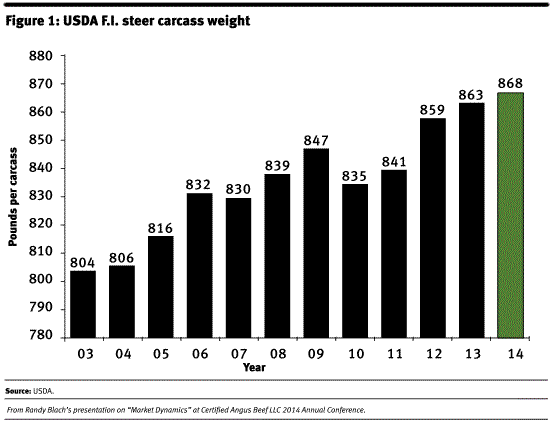Did You Know?
The beef with ever-heavier carcass weights.
Yes, the coffee-shop talk in cattle country usually starts with cattle prices. However, it does not take long before the talk turns to how big these fed cattle are getting.
In early September, we heard the report of a record high for steer carcass weight of 885 pounds (lb.). By mid-September that was 889 lb.; by mid-October it was 896 lb.
Each pound of added carcass weight creates 0.6 lb. of edible product, so every 5-lb. increase nets 3 lb. more beef on the plate.As you can see in the figure (below), few things have been as linear in the past 20 years as average carcass weight increases. Even $8 corn did not slow the trend.
So why is this occurring? We would argue genetics is a huge part of the equation. Today’s cattle can be fed to 950-lb., or even 1,000-lb., carcasses without excess fat.
Certainly feeding and management strategies have had an impact. Today, many feeder cattle are grown to 850-900 lb. before entering a feedlot. Utilization of beta-agonists has also had an impact.
Is this trend good or bad? A bit of both. As an industry, it has allowed continued growth in beef production with fewer cows, but it has presented a challenge for our foodservice partners who want to serve an ideal steak.
You may know all of this, and that steer carcasses outweigh those from heifers. Here are some points I bet you did not know about carcass weights.
First, the degree of difference in steer and heifer carcasses is a bit surprising these days at 85 lb. Two years ago that was only 68 lb., which makes us wonder why the increase? One can only speculate, but perhaps heavier heifers are being retained for breeding.
Second, a little informal math reveals the impact of heavier carcasses on the amount of beef for sale: Each pound of added carcass weight creates 0.6 lb. of edible product, so every 5-lb. increase nets 3 lb. more beef on the plate.
What does it mean for the Certified Angus Beef® (CAB®) brand? Today, our average steer and heifer combined carcass weight average is 866 lb., compared to 856 lb. a year ago. Historically, CAB® carcass weights tag along with industry averages.
Why does the restaurant trade fuss about heavy carcasses? Part of it relates to the great variability in the size of the whole rib or loin primal in a box, and how that affects ribeye size, steak thickness, cooking and plate presentation.
An interesting study was done by meat scientists Leich and Behrends at Mississippi State University.
They collected strip loin, ribeye and top butt (sirloin) primals from carcasses weighing 500, 600, 700, 800 and 900 lb. Then they cut 12-oz. ribeye and strip steaks or 10-oz. sirloin steaks. To achieve these steak weights, the thickness of the ribeye/strip steak was 2 inches (in.) for the light carcass weights, but only 0.85 in. for the steaks from heavy carcasses. For the sirloin, the range was from 1.1 in. to 1.9 in. Now we can see the cooking challenge our industry presents for the chef.
Will the increases continue? No one’s crystal ball is perfect, but we would speculate with current grain and cattle prices and market logic, the 900-lb. mark will soon be history as carcasses keep getting heavier.


Editor’s Note: Larry Corah is vice president of supply development for Certified Angus Beef LLC (CAB).





